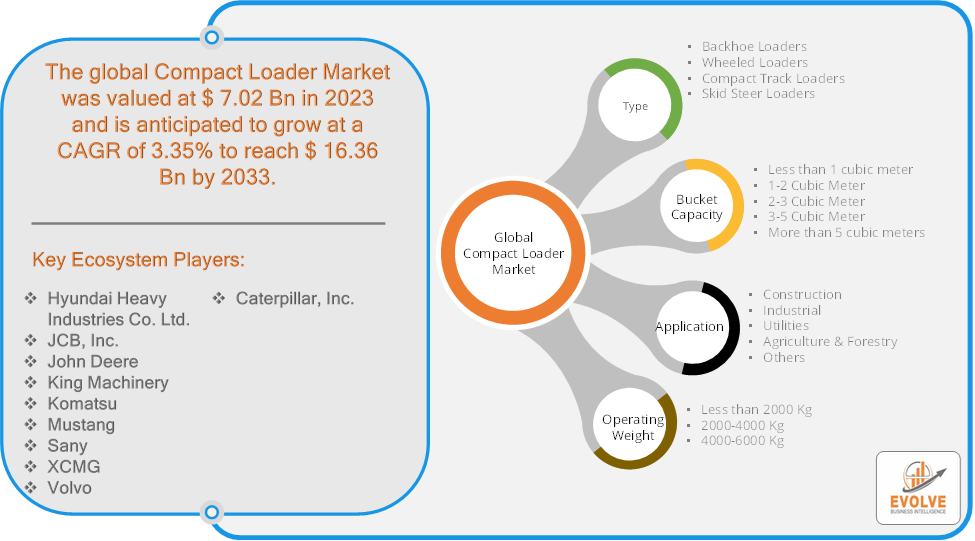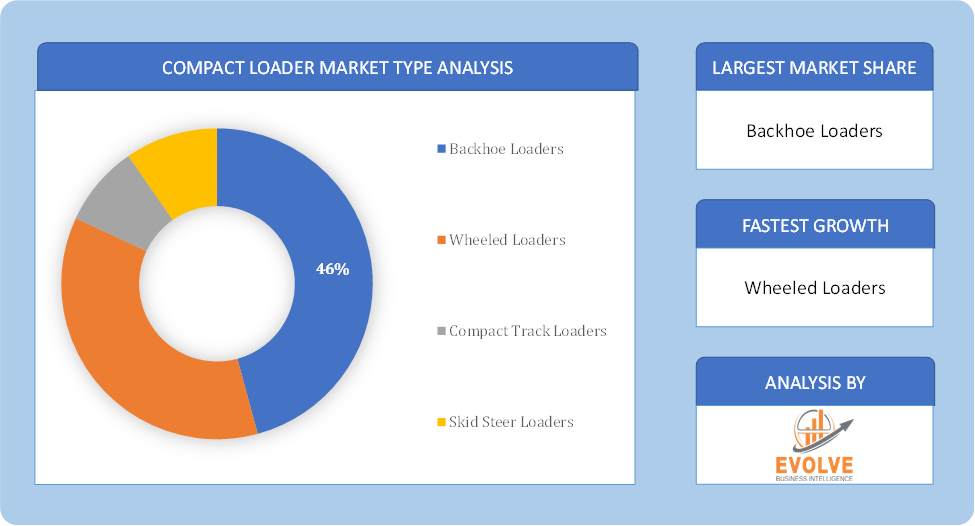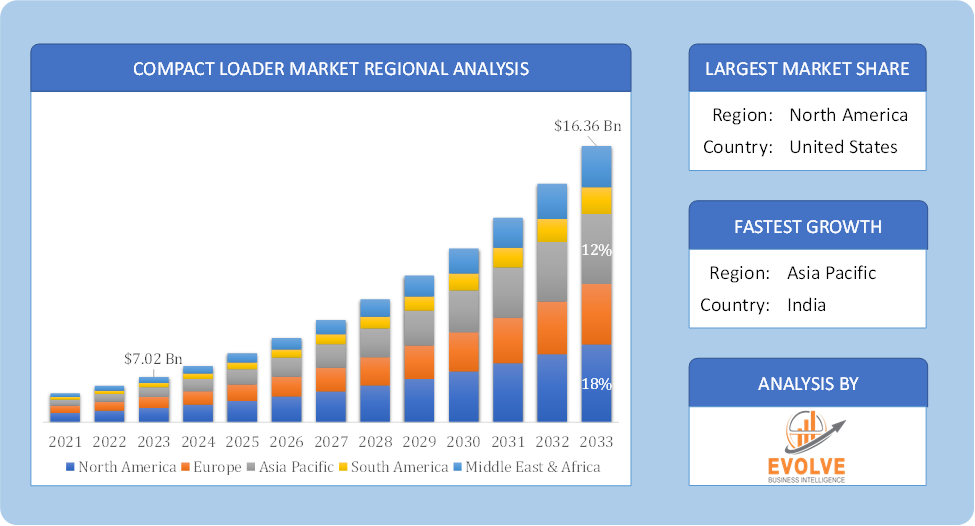Compact Loader Market Overview
Compact Loader Market Size is expected to reach USD 16.36 Billion by 2033. The Compact Loader industry size accounted for USD 7.02 Billion in 2023 and is expected to expand at a compound annual growth rate (CAGR) of 3.35% from 2023 to 2033. The compact loader market encompasses small, versatile construction machinery designed for various tasks such as digging, loading, and material handling in confined spaces. These loaders are widely used in construction, agriculture, landscaping, and municipal applications due to their maneuverability and efficiency. The market is driven by increasing urbanization, infrastructure development, and demand for compact equipment with advanced features like improved hydraulic systems and operator comfort. Key players in this market focus on technological innovations, expanding product portfolios, and strategic partnerships to maintain a competitive edge. The market also benefits from growing environmental awareness, leading to the adoption of electric and hybrid models.
Global Compact Loader Market Synopsis

COVID-19 Impact Analysis
The COVID-19 pandemic has led to supply chain disruptions leading to supply shortages or lower demand in the Compact Loader market. The travel restrictions and social-distancing measures have resulted in a sharp drop in consumer and business spending and this pattern is to continue for some time. The end-user trend and preferences have changed due to the pandemic and have resulted in manufacturers, developers, and service providers adopting various strategies to stabilize the company.
Global Compact Loader Market Dynamics
The major factors that have impacted the growth of Compact Loader are as follows:
Drivers:
⮚ Technological Innovations
Continuous advancements in technology have led to the development of more efficient and feature-rich compact loaders. Innovations such as improved hydraulic systems, advanced telematics, operator-friendly interfaces, and enhanced safety features have significantly increased the operational efficiency and appeal of these machines. Manufacturers are investing heavily in research and development to introduce new models with better performance, which in turn drives market growth.
Restraint:
- High Initial Investment Costs
One of the primary restraints in the compact loader market is the high initial cost associated with purchasing these machines. Compact loaders, particularly those with advanced features and technologies, require significant capital investment. This can be a substantial financial burden for small and medium-sized enterprises (SMEs) and individual contractors, limiting their ability to acquire new equipment.
Opportunity:
⮚ Rising Demand for Electric and Hybrid Models
Increasing environmental awareness and stringent emission regulations are driving the demand for electric and hybrid compact loaders. These eco-friendly alternatives reduce carbon emissions, noise pollution, and operating costs, making them attractive to environmentally conscious customers. Manufacturers focusing on developing and commercializing electric and hybrid models stand to capitalize on this growing market segment.
Compact Loader Market Segment Overview
 By Type
By Type
Based on the Type, the market is segmented based on Backhoe Loaders, Wheeled Loaders, Compact Track Loaders, Skid Steer Loaders. the segment with bucket capacities of 1-2 cubic meters typically dominates. This range is versatile enough to handle a wide variety of materials and tasks across construction, agriculture, and landscaping applications, striking a balance between efficiency and maneuverability.
By Bucket Capacity
Based on Bucket Capacity, the market has been divided into Less Than 1 Cubic Meter, 1-2 Cubic Meter, 2-3 Cubic Meter, 3-5 Cubic Meter, More Than 5 Cubic Meter. the segment with bucket capacities of 1-2 cubic meters typically dominates. This range strikes a balance between operational versatility and efficiency, making it suitable for a wide range of applications in construction, agriculture, and landscaping where moderate to heavy-duty material handling is required.
By Application
Based on the Application, the market has been divided into Construction, Industrial, Utilities, Agriculture & Forestry, Others. the construction sector typically dominates based on application. Compact loaders are extensively used in construction for tasks such as loading, material handling, and light excavation due to their versatility, maneuverability, and ability to operate in confined spaces, making them indispensable in urban and residential construction projects.
By Operating Weight
Based on Operating Weight, the market has been divided into Less Than 2000 Kg, 2000-4000 Kg, 4000-6000 Kg, More Than 6000 Kg. he segment dominating based on operating weight is typically the 2000-4000 Kg range. This segment strikes a balance between maneuverability and load capacity, making it versatile for various construction, agriculture, and landscaping applications while still being manageable in terms of size and operational efficiency.
Global Compact Loader Market Regional Analysis
Based on region, the market has been divided into North America, Europe, Asia-Pacific, the Middle East & Africa, and Latin America. The area of Asia-Pacific is anticipated to dominate the market for the usage of Compact Loader, followed by those in North America and Europe.
 Compact Loader Asia-Pacific Market
Compact Loader Asia-Pacific Market
The Asia-Pacific region holds a dominant position in the Compact Loader market. The market for compact loaders with the fastest growth is anticipated to be in Asia-Pacific. Recent years have seen a sharp increase in the region’s construction industry, which can be attributed to expanding industrialization, infrastructure development, and urbanization. The construction industry is now in more need of compact loaders as a result of this. The region’s agriculture industry is another important compact loader end-user, which is fostering the market’s expansion. The market in the area is also being driven by the growing usage of compact loaders in mining activities.
Compact Loader North America Market
The North America region is witnessing rapid growth and emerging as a significant market for the Compact Loader industry. The compact loader market in North America is anticipated to expand at the fastest rate possible between 2023 and 2030. The increasing number of construction projects in North America is mostly attributable to the construction industry, which in turn drives up demand for compact loaders. In the area, compact loaders are also being used more often in agriculture and landscaping.
Competitive Landscape
The competitive landscape includes key players (tier 1, tier 2, and local) having a presence across the globe. Companies such as Hyundai Heavy Industries Co. Ltd., JCB, Inc., John Deere, King Machinery, and Komatsu are some of the leading players in the global Compact Loader Industry. These players have adopted partnership, acquisition, expansion, and new product development, among others as their key strategies.
Key Market Players:
- Hyundai Heavy Industries Co. Ltd.
- JCB, Inc.
- John Deere
- King Machinery
- Komatsu
- Mustang
- Sany
- XCMG
- Volvo
- Caterpillar, Inc.
Key Development:
In September 2022, Hyundai Heavy Industries Co. Ltd. focused on expanding its construction equipment portfolio by introducing new, technologically advanced models aimed at enhancing efficiency and sustainability in their operations. This included significant innovations in compact loader designs to meet growing market demands.
Scope of the Report
Global Compact Loader Market, by Type
- Backhoe Loaders
- Wheeled Loaders
- Compact Track Loaders
- Skid Steer Loaders
Global Compact Loader Market, by Bucket Capacity
- Less than 1 cubic meter
- 1-2 Cubic Meter
- 2-3 Cubic Meter
- 3-5 Cubic Meter
- More than 5 cubic meters
Global Compact Loader Market, by Application
- Construction
- Industrial
- Utilities
- Agriculture & Forestry
- Others
Global Compact Loader Market, by Operating Weight
- Less than 2000 Kg
- 2000-4000 Kg
- 4000-6000 Kg
Global Compact Loader Market, by Region
- North America
- US
- Canada
- Mexico
- Europe
- UK
- Germany
- France
- Italy
- Spain
- Benelux
- Nordic
- Rest of Europe
- Asia Pacific
- China
- Japan
- South Korea
- Indonesia
- Austalia
- Malaysia
- India
- Rest of Asia Pacific
- South America
- Brazil
- Argentina
- Rest of South America
- Middle East & Africa
- Saudi Arabia
- UAE
- Egypt
- South Africa
- Rest of Middle East & Africa
| Parameters | Indicators |
|---|---|
| Market Size | 2033: USD 16.36 Billion |
| CAGR (2023-2033) | 3.35% |
| Base year | 2022 |
| Forecast Period | 2023-2033 |
| Historical Data | 2021 (2017 to 2020 On Demand) |
| Report Coverage | Revenue Forecast, Competitive Landscape, Growth Factors, and Trends |
| Key Segmentations | Type, Bucket Capacity, Application, Operating Weight |
| Geographies Covered | North America, Europe, Asia-Pacific, South America, Middle East, Africa |
| Key Vendors | Hyundai Heavy Industries Co. Ltd., JCB, Inc., John Deere, King Machinery, Komatsu, Mustang, Sany, XCMG, Volvo, Caterpillar, Inc. |
| Key Market Opportunities | · Rapid urbanization · Unprecedented growth in the construction sector · Increase in focus on innovation in green construction materials |
| Key Market Drivers | · Demand for vertical lift compact loaders · Rising demand for road planner surfaces. |
REPORT CONTENT BRIEF:
- High-level analysis of the current and future Compact Loader Industry trends and opportunities
- Detailed analysis of current market drivers, restraining factors, and opportunities analysis in the future
- Historical market size for the year 2021, and forecast from 2023 to 2033
- Compact Loader market share analysis for each segment
- Competitor analysis with a comprehensive insight into its product segment, financial strength, and strategies adopted.
- Identifies key strategies adopted by the key players including new product development, mergers and acquisitions, joint ventures, collaborations, and partnerships.
- To identify and understand the various factors involved in the global Compact Loader market affected by the pandemic
- To provide year-on-year growth from 2022 to 2033
- To provide short-term, long-term, and overall CAGR comparison from 2022 to 2033.
- Provide Total Addressable Market (TAM) for the Global Compact Loader Market.


 Compact Loader Asia-Pacific Market
Compact Loader Asia-Pacific Market


